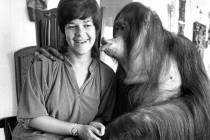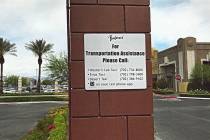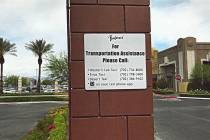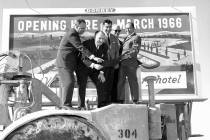Idea of shining city upon a hill seems almost too good to be true
From the Sermon on the Mount to speeches by Presidents Kennedy and Reagan, the concept of a “city upon a hill” has been a positive. Unless the hill is Blue Diamond Hill.
Yet as urban planner Ron Krater described the plan of a new city near the Red Rock National Conservation Area, it sounded almost too good to be true. A college up there? Light industry? Affordable homes? Sounds like fantasyland. But admirable, if it were anywhere else.
Count me among the thousands who don’t want to see a shining city upon that particular hill, even though it’s a hill scarred by decades of gypsum mining. I doubt seriously whether the five Clark County commissioners who voted to approve the concept want to see it either.
But they are advised repeatedly by Deputy District Attorney Rob Warhola, who tells them that Jim Rhodes and his brother John, owners of the land, have property rights under established law, and if they reject the massive project, then U.S. District Judge Robert Clive Jones will be calling the shots.
Jones approved an earlier settlement agreement between developer Rhodes and Clark County, and if either side negotiates in bad faith, critical issues can end up being decided by him.
Warhola’s advice to the opponents of putting a city with a population of 30,000 atop the hill is to find some concrete reasons to deny the project, not just emotional reasons.
Commissioner Chris Giunchigliani mentioned specific concerns she thought could give the commissioners the ability to block the
$2.3 billion project, but Warhola said he hadn’t heard anything that he could defend in court as a reason to deny Rhodes at this stage.
Feeling cornered, Commissioner Susan Brager, who represents that area, said because Warhola had gone to law school and Giunchigliani hasn’t, she would follow his advice.
While Commissioner Lawrence Weekly aligned with Giunchigliani in opposition, Commissioners Larry Brown, Tom Collins, Mary Beth Scow and Steve Sisolak all said how much they loved Red Rock, then voted to approve the rough concept of this city on a hill.
There are clearly problems with the concept. Would you like to live in a community where there is only one road in and out and it would be a steep one? How hard (and expensive) will it be to get water and sewer lines to an estimated 7,000 homes, if Rhodes gets his way.
Does he even have the money to do it after putting most of his companies into bankruptcy? What about his projects that have failed? Or those lawsuits where his ex-partners say he’s not the most ethical in his business practices? And will the Bureau of Land Management swap acreage he needs for the project?
Noticeably, Rhodes’ name was never mentioned by those advocating on his behalf during the six-hour plus hearing Wednesday.
The property is zoned R-U, so he could start building one home on every two acres and nobody could stop him. But that wouldn’t be profitable. He needs density to make profit. Rhodes asked for 2.9 housing units an acre.
Brager’s motion was to limit that to an average of 2.5 units per acre. She said they needed to return with right-of-way access approved by the BLM and eliminate light industry. The approval is not a declaration that the county is supporting a land swap with the BLM.
Can Rhodes still make money with those restrictions? That’s his decision.
But it is feasible? As Krater described it, it sounded magical. But if commissioners continue to pile on restrictions, it might become less and less feasible. Those who love Red Rock and Blue Diamond can hope — and look for concrete evidence why this proposal isn’t feasible.
“A city that is set upon a hill cannot be hidden,” Jesus said.
And that’s the problem on Blue Diamond Hill.
Jane Ann Morrison’s column appears Monday, Thursday and Saturday. Email her at Jane@reviewjournal.com or call her at (702) 383-0275. She also blogs at lvrj.com/blogs/Morrison












